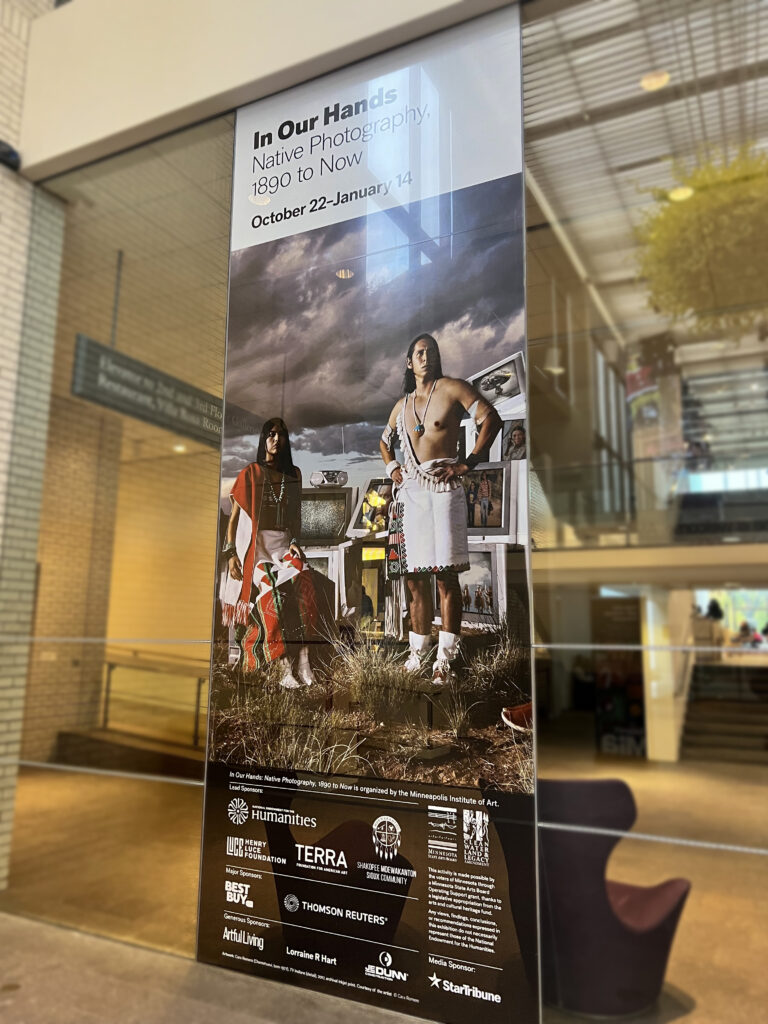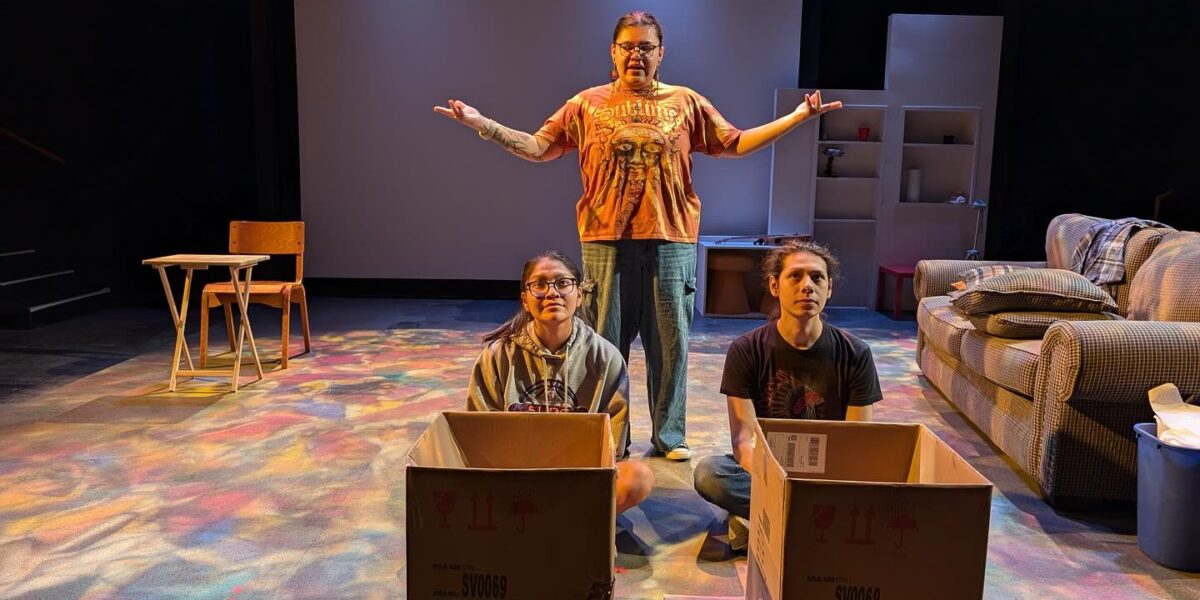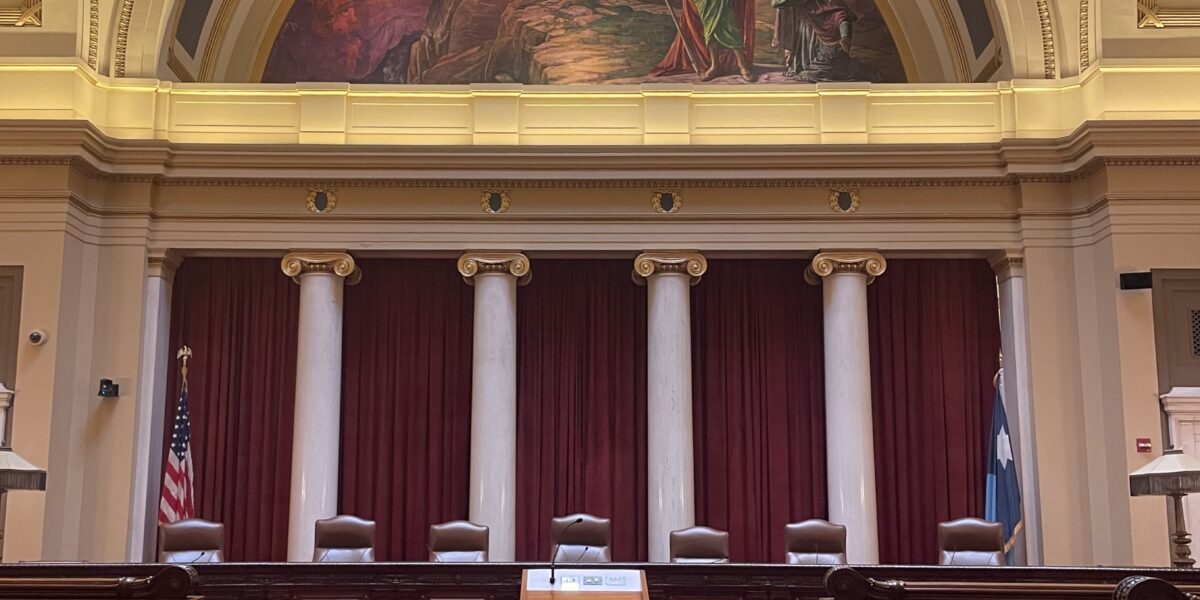
| The Minneapolis Institute of Arts (MIA) opened the “In Our Hands” photography exhibition, highlighting images taken from the viewpoint of Indigenous people. The exhibition was inspired by and co-curated by artist Jaida Grey Eagle after serving as a fellow at MIA. |
Announcer: This is Minnesota Native News. This week, the Minneapolis Institute of Art is currently holding an exhibition focusing on indigenous photography from the late 1890’s to the present day. Reporter Chandra Colvin has the story.
Chandra Colvin: In October, the Minneapolis Institute of Art, also known as the MIA, opened an exhibition focused on Native Photography titled, “In Our Hands.” The exhibit was formed primarily by a council of Native artists and scholars. Jaida Grey Eagle, who is a member of the Oglala Lakota Sioux tribe, is a photographer and artist. She is a co-curator for the exhibit and was the initial inspiration for it during her time as a fellow at the MIA.
Jaida Grey Eagle: I’ve been practicing photography since I was a young kid. I think I was probably 11 when I got my first camera. Native, you’re always wondering, “are there other people doing what I’m doing?” In schools here, they never talk about Native photographers in Minnesota. And it wasn’t until I went to the Institute of American Indian Arts down in Santa Fe that I was introduced to this whole world of native photographers. Why do I have to travel so far away from home to find that? Why is that just not talked about?
I think for myself, I just, I really want it to inspire people, and to just introduce them to this incredible history of, you know, Native people practicing the art of photography. It’s such a different experience to see photography from the viewpoint of Native people. So it’s inspiring to me, and I just hope that it’s inspiring to other people to just see the art practiced by the people themselves that it’s about.
CC: The Native artists and scholars worked alongside MIA curators, like Jill Oberg, a curator of Native arts and a co-curator of the exhibit.
Jill Oberg:Jaida was our fellow at the time. And she came in and asked us about our collection of photography made by Native people. And we came together and we knew that we didn’t have many. And that we needed to build that. So it was a great way for us to understand the field through going to the experts who have been dedicating their entire lives to the field. And that was the beginning of the exhibition.
CC: The exhibit features over 150 photographs by, of, and for Native people. Joseph Allen, who is a member of the Rosebud Sioux tribe and a direct descendent of White Earth Nation, has been doing photography for 30 years. His featured piece titled, “Free Land,” was captured in front of the MIA in 1992.
Joseph Allen: From that original image that, you know, is in the show – it’s such a small piece, it’s 8in by 10in. But that connection back to that beginning, I lived in Minneapolis for 25 years. And so and then having that image taken on the grounds of the MIA, that really connects to my career, you know, as a photographer it means a lot.
CC: Allen said it’s an honor to be a Minnesota-based photographer featured in the exhibit. Co-curator Casey Riley agrees.
Casey Riley: We say this throughout the sort of overviews of the show, but, you know, this really was a show first and foremost, for Native audiences, and Native visitors. And, you know, this, hopefully, is an invitation to many younger photographers to join the profession, and continue this work, because there are so many amazing people who have influenced the medium from the beginning. And I would say that for me as someone who’s trained in photo history, that is a really important message for all of us who have studied the field. Native people have been left out of our discourse, and they have been so important to its development. I think it’s a really important takeaway. That, you know, the canon needs to change.
CC: “In Our Hands” will be on display at the Minneapolis Institute of Arts until January 14th [2024]. Members of the indigenous community can visit for free. For Minnesota Native News, this is Chandra Colvin.
Announcer: For more information on the In Our Hands exhibit, visit the MIA’s website at new.artsmia.org.
More from Minnesota Native News
- New Native Theatre’s 15th Year & REAL ID
 This week, how REAL ID requirements impact Indigenous people, especially Two-Spirit individuals. Also, New Native Theatre’s latest play runs April 16-May 4.
This week, how REAL ID requirements impact Indigenous people, especially Two-Spirit individuals. Also, New Native Theatre’s latest play runs April 16-May 4. - Ziigwan Biidaajimowin (Spring News): NACC Issues Call for Artists and Little Earth Kicks Off American Indian Month with a Parade
 This week, Minneapolis’s Native American Community Clinic (NACC) seeks artists to commission pieces for their new building. Plus, nearby, the Little Earth of United Tribes housing community will kick off May’s American Indian Month with a celebration organized in part by the Minneapolis Public Schools American Indian Youth Council, Ogichida Oyate
This week, Minneapolis’s Native American Community Clinic (NACC) seeks artists to commission pieces for their new building. Plus, nearby, the Little Earth of United Tribes housing community will kick off May’s American Indian Month with a celebration organized in part by the Minneapolis Public Schools American Indian Youth Council, Ogichida Oyate - Indian Child Welfare Law Challenged at MN Supreme Court and Native Nations Impacted by Proposed SAVE Act
 This week, the Minnesota Supreme Court heard arguments in a case that could reshape child custody laws for Native American children. Also, the Safeguard American Voter Eligibility (SAVE) Act would require all Americans to prove their citizenship in person with official documents when registering to vote.
This week, the Minnesota Supreme Court heard arguments in a case that could reshape child custody laws for Native American children. Also, the Safeguard American Voter Eligibility (SAVE) Act would require all Americans to prove their citizenship in person with official documents when registering to vote.
Subscribe to Minnesota Native News in your favorite podcast app

 Eagle and Condor Native Wellness Center Opens in East Saint Paul
Eagle and Condor Native Wellness Center Opens in East Saint Paul